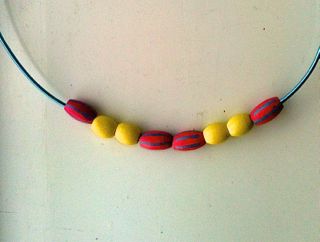Or search by topic
Number and algebra
Geometry and measure
Probability and statistics
Working mathematically
Advanced mathematics
For younger learners
School Fair Necklaces



- Problem
- Getting Started
- Student Solutions
- Teachers' Resources
School Fair Necklaces
Rob and Jennie were making necklaces to sell at the school fair.
They decided to make them very mathematical.
Each necklace was to have eight beads, four of one colour and four of another.
And each had to be symmetrical, like this.

How many different necklaces could they make?
Can you find them all?
How do you know you haven't missed any out?
What if they had 9 beads, five of one colour and four of another?
What if they had 10 beads, five of each?
What if...?
Why do this problem?
This low threshold high ceiling task offers opportunities for children to confirm their understanding of line symmetry, to appreciate why working systematically is useful, and be introduced, or develop for themselves, a proof by exhaustion.
Possible approach
This problem featured in an NRICH Primary webinar in March 2022.
Most children will find some practical apparatus useful for this activity. Beads and string are the obvious choice but can lead to frustration if threading and re-threading is time consuming. A better bet may be interlocking cubes which can be stuck together (and can always be threaded later to make a display) or other similar objects in two colours. If you don't have an IWB (or even if
you do) you may want to make some versions of the necklace on large strips of paper which children can hold up at the front for all to see.
Introduce the task and together with the children, generate a symmetrical necklace. Challenge them to work in pairs to find as many other symmetrical necklaces as possible using eight beads, four each of two colours. When they think they have found as many as possible, they can record them on strips of paper (you could use this sheet cut
into individual strips). Giving separate slips of paper as opposed to a single worksheet will mean the children will be able to arrange and rearrange them.
Can they now arrange the strips to help them to see whether they have found all the necklaces?
Whilst they are doing this, copy the results they have found onto the large strips and then invite children to come and hold them up at the front. Ask "Do we have them all? How do we know? How can we be sure?" Encourage individual children to come to the front and rearrange the strips by moving their classmates around.
The most usual reponse to this is that the necklaces fall into pairs, each the inverse of the other (RRBBBBRR and BBRRRRBB, for example). Point out that this helps us to know that there should be an even number of solutions, but it doesn't prove that we have found them all - there might well be another pair that we haven't found yet.
Give some time for the children to rearrange their own strips and if anyone thinks they have found a way to show that they have found them all, invite them to come to the front and rearrange the large strips. If no-one does, you mght want to leave the children for some time - or even ask them to take the problem home - before sharing the proof below.
Focus first on the strips that begin with a red bead.
Arrange them so that the second red bead is in position 2, then position 3 and finally position 4:
RRBB BBRR
RBRB BRBR
RBBR RBBR
This must be the full set of necklaces beginning with a red bead since the second bead has been placed in each of the three other places.
If there are three beginning with red, there must also be three beginning with blue.
This exemplification of every possible solution is known as 'proof by exhaustion'.
Key questions
Can you make another?
How are these different?
How are these the same?
How do you know that is symmetrical?
Is your pattern the same as ...'s?
Do you think there are any more? Why/why not?
Can you show me why you think you've got them all?
Possible support
For some children producing more than one necklace will be a challenge, and transferring a pattern accurately onto paper will also be difficult, but worthwhile. Support them in looking for the same pattern using different colour combinations, for example RGRGGRGR is the same underlying pattern as BYBYYBYB. Making generalisations like this is a very important part of thinking like a mathematician.
Possible extension
Some children will be very interested in justifying their claim that they have found all the possibilities. Listen to their explanations - this is a wonderful opportunity for them to reason mathematically, and is the beginning of understanding mathematical proof.
Once they have convinced you, offer them nine beads, five of one colour and four of another. What difference does this make? What about ten, eleven, etc? Can they state any rules about the number of beads they need to make a symmetrical necklace with two colours?
Related Collections
You may also like
Let's Investigate Triangles
Vincent and Tara are making triangles with the class construction set. They have a pile of strips of different lengths. How many different triangles can they make?

